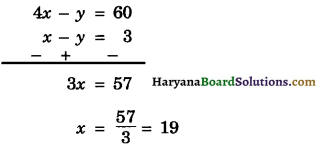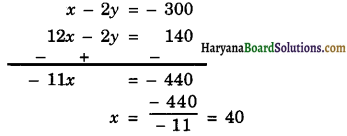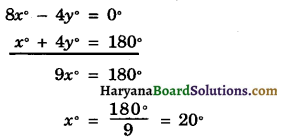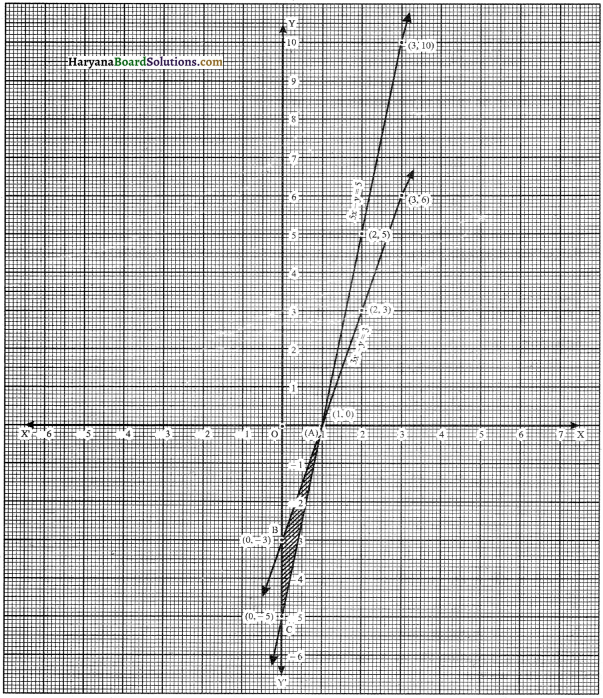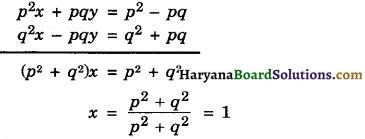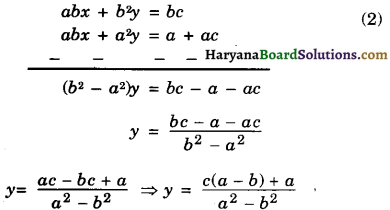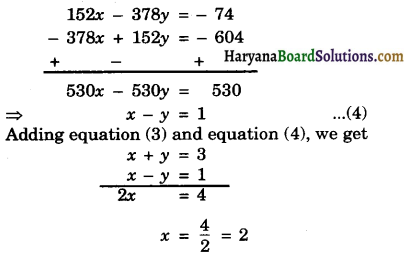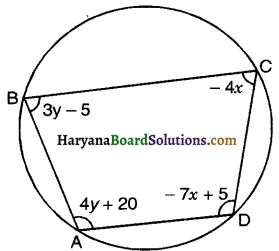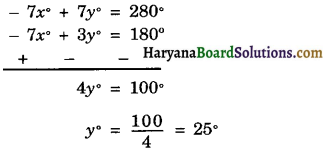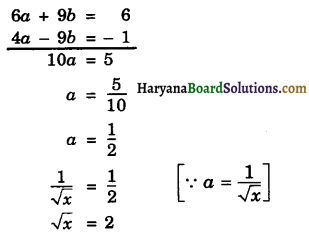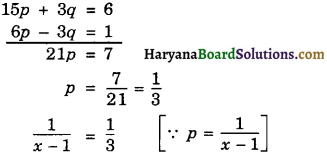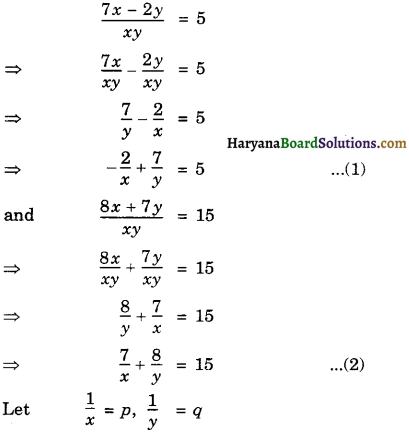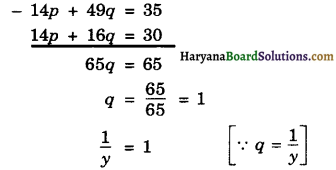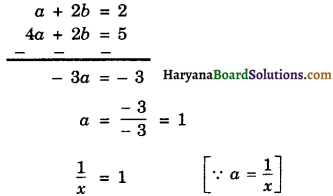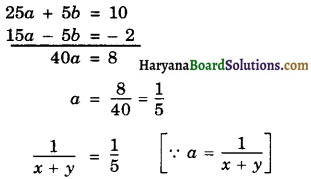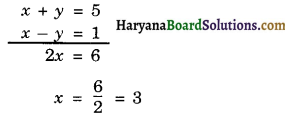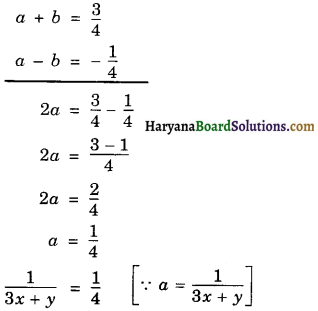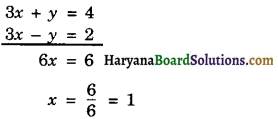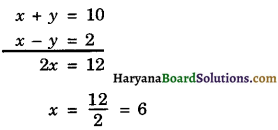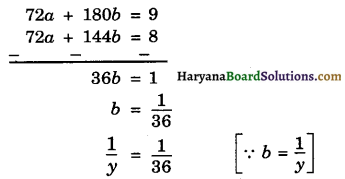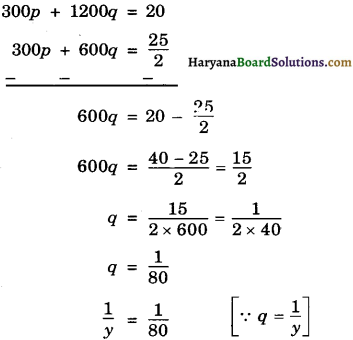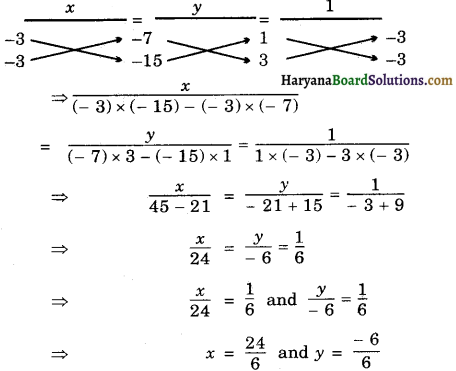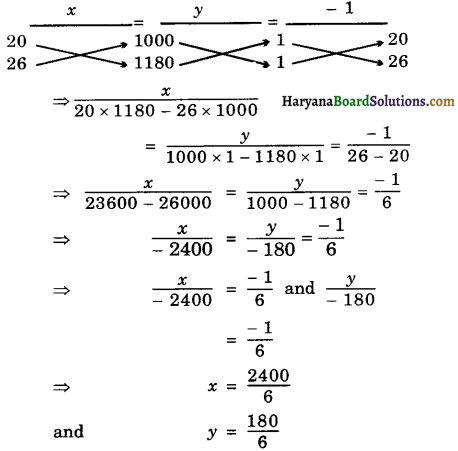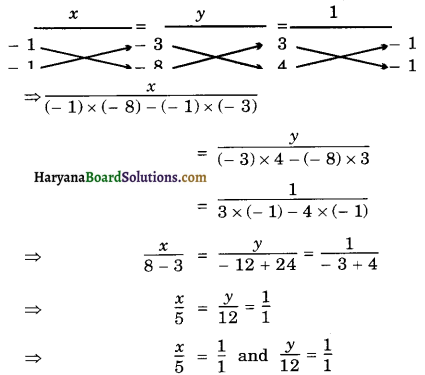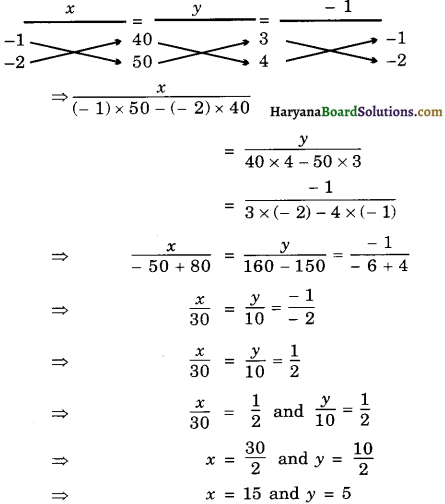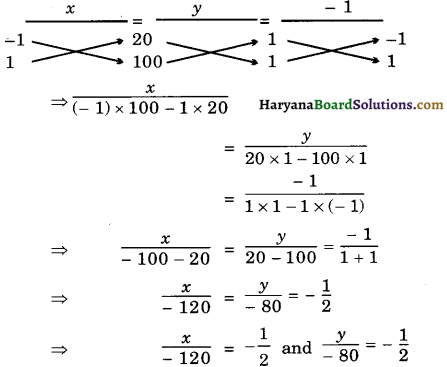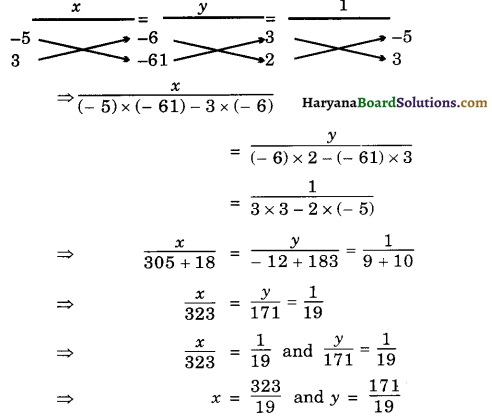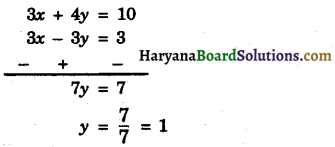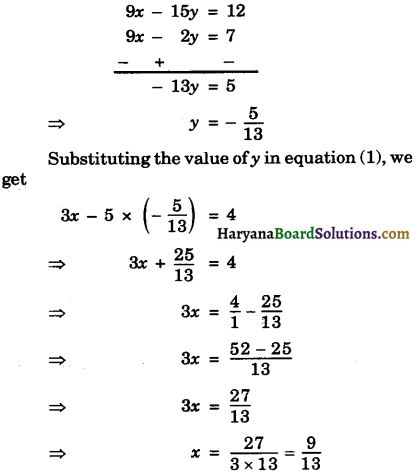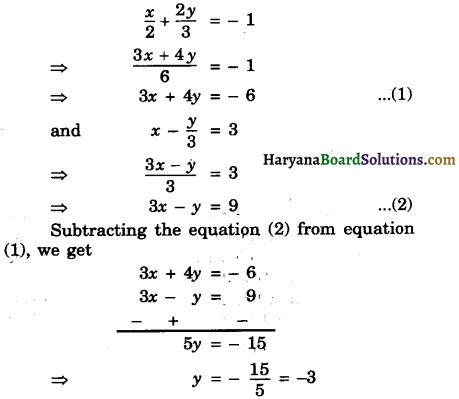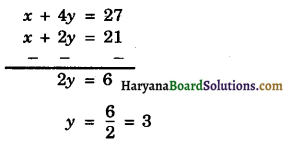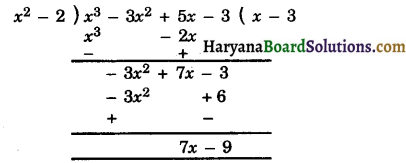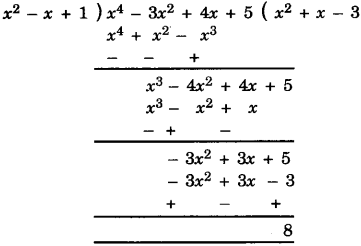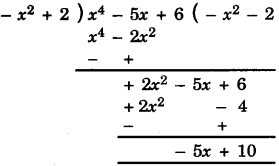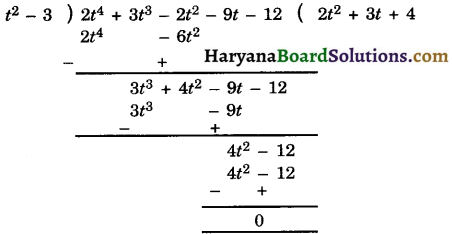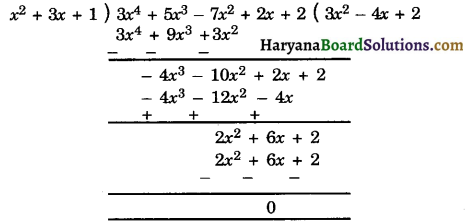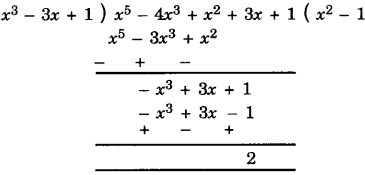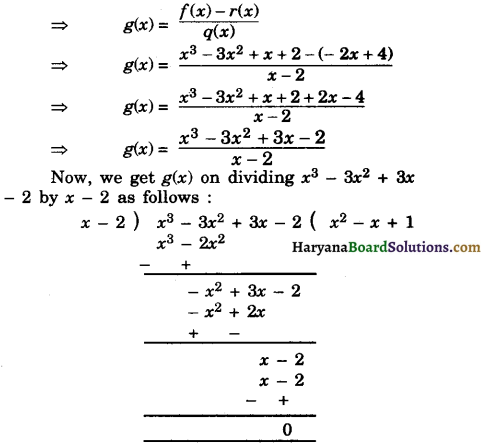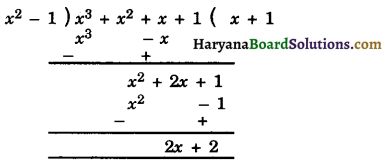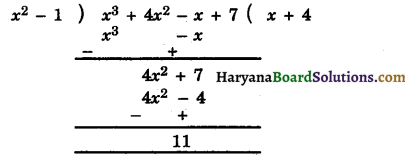Haryana State Board HBSE 10th Class Maths Solutions Chapter 5 Arithmetic Progressions Ex 5.1 Textbook Exercise Questions and Answers.
Haryana Board 10th Class Maths Solutions Chapter 5 Arithmetic Progressions Ex 5.1
Question 1.
In which of the following situations, does the list of numbers involved make an arithmetic progression, and why?
(i) The taxi fare after each km when the fare is ₹ 15 for the first km and ₹ 8 for each additional km.
(ii) The amount of air present in a cylinder when a vacuum pump removes \(\frac{1}{4}\) of the air remaining in the cylinder at a time.
(iii) The cost of digging a well after every metre of digging, when it costs ₹ 150 for the first metre and rises by ₹ 50 for each subsequent metre.
(iv) The amount of money in the account every year, when ₹ 10000 is deposited at compound interest at 8% per annum.
Solution :
(i) We have,
Taxi fare for 1 km = ₹ 15
Taxi fare for each additional km = ₹ 8
Let a1, a2, a3, a4 …………… be the fares for 1 km, 2 km, 3 km, 4 km ………….. respectively.
∴ a1 = ₹ 15
a2 = 15 + 8 = ₹ 23
a3 = 15 + 2 × 8 = ₹ 31
a4 = 15 + 3 × 8 = ₹ 39 and so on.
The sequence is 15, 23, 31, 39, …………..
Now, a2 – a1 = 23 – 15 = 8
a3 – a2 = 31 – 23 = 8
a4 – a3 = 39 – 31 = 8
a2 – a1 = a3 – a2 = a4 – a3
The sequence 15, 23, 31, 39, …………….. forms an AP.

(ii) Let the amount of air present in the cylinder be x units
and let the amount of air remained after each pump be a2, a3, a4, … respectively.
∴ a1 = x units.

∵ a3 – a2 ≠ a2 – a1
Hence, the sequence x, \(\frac{3 x}{4}, \frac{9 x}{16}, \frac{27 x}{64}, \ldots\) does not form an AP.
(iii) Let the cost of 1m, 2m, 3m, …….. be ₹ a1, ₹ a2, ₹ a3, … respectively.
a1 = ₹ 150
a2 = 150 + 50 = ₹ 200
a3 = 150 + 2 × 50 = ₹ 250 and so on.
The sequence is 150, 200, 250, ………………
Now, a2 – a1 = 200 – 150 = ₹ 50
a3 – a2 = 250 – 200 = ₹ 50
∵ a2 – a1 = a3 – a2
Hence, the sequence 150, 200, 250, ………….. forms an A.P.

(iv) Amount deposited in the bank = ₹ 10000
Rate of interest = 8% per annum.
Let the amounts in bank after 1 year, 2 year, 3 years, … are ₹ a1, ₹ a2, ₹ a3, ………….. respectively.
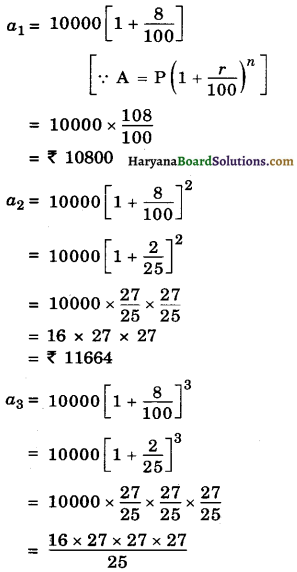
= ₹ 12597.12 and so on.
The sequence is 10800, 11664, 12597.12, ………………
Now, a2 – a1 = 11664 – 10800 = 864
a3 – a2 = 12597.12 – 11664 = 933.12
∵ a2 – a1 ≠ a3 – a2
Hence, the sequence 10800, 11664, 12597.12, …………… does not form an AP.

Question 2.
Write first four terms of the AP, when the first term a and the common difference d are given as follows :
(i) a = 10, d = 10
(ii) a = – 2, d = 0
(iii) a = 4, d = – 3
(iv a = – 1, d = \(\frac{1}{2}\)
(v) a = – 1.25, d = – 0.25.
Solution :
(i) We have, a = 10, d = 10
First four terms of required AP are
a1 = a = 10
a2= a + d = 10 + 10 = 20
a3 = a2 + d
= 20 + 10 = 30
a4 = a3 + d
= 30 + 10 = 40
Hence, the first four terms of AP are 10, 20, 30, 40.
(ii) We have, a = – 2, d = 0
First four terms of required AP are
a1 = a = – 2
a2 = a1 + d
= – 2 + 0 = – 2
a3 = a2 + d
= – 2 + 0 = – 2
a4 = a3 + d
= – 2 + 0 = – 2
Hence, the first four terms of AP are – 2,- 2, – 2, – 2.

(iii) We have, a = 4, d = – 3
First four terms of required AP are
a1 = a = 4
a2 = a1 + d
= 4 – 3 = 1
a3 = a2 + d
= 1 – 3 = – 2
a4 = a3 + d
= – 2 – 3 = – 5
Hence, the first four terms of AP are 4, 1, – 2, – 5.
(iv) We have, a = – 1, d = \(\frac{1}{2}\)
First four terms of required AP are
a1 = a = – 1
a2 = a1 + d
= – 1 + \(\frac{1}{2}\) = – \(\frac{1}{2}\)
a3 = a2 + d
= – \(\frac{1}{2}\) + \(\frac{1}{2}\) = 0
a4 = a3 + d
= 0 + \(\frac{1}{2}\) = \(\frac{1}{2}\)
Hence, the first four terms of AP are – 1, – \(\frac{1}{2}\), 0, \(\frac{1}{2}\).

(v) We have, a = – 1.25, d = – 0.25
First four terms of required AP are
a1 = a = – 1.25
a2 = a1 + d
= – 1.25 – 0.25 = – 1.50
a3 = a2 + d
= – 1.50 – 0.25 = – 1.75
a4 = a3 + d
= – 1.75 – 0.25 = – 2.00
Hence, the first four terms of AP are – 1.25, – 1.50, – 1.75, – 2.00.
Question 3.
For the following APs, write the first term and the common difference:
(i) 3, 1, – 1, – 3, ……………
(ii) – 5, – 1, 3, 7, ……………..
(iii) \(\frac{1}{3}, \frac{5}{3}, \frac{9}{3}, \frac{13}{3}, \ldots\)
(iv) 0.6, 1.7, 2.8, 3.9, ……………
Solution :
(i) The given sequence is 3, 1, – 1, – 3, ……………..
Here, a = 3, d = 1 – 3 = – 2
Hence, a = 3, d = – 2.
(ii) The given equation is – 5,- 1, 3, 7, …………..
Here, a = – 5
d = – 1 – (- 5) = – 1 + 5 = 4
Hence a = – 5, d = 4.
(iii) The given sequence is \(\frac{1}{3}, \frac{5}{3}, \frac{9}{3}, \frac{13}{3}, \ldots\)
Here, a = \(\frac{1}{3}\)
d = \(\frac{5}{3}-\frac{1}{3}=\frac{4}{3}\)
Hence, a = \(\frac{1}{3}\), d = \(\frac{4}{3}\)
(iv) The given sequence is 0.6, 1.7, 2.8, 3.9, …………….
Here, a = 0.6
d = 1.7 – 0.6 = 1.1
Hence, a = 0.6, d = 1.1.

Question 4.
Which of the following are APs? If they form an AP, find the common difference d and write next three more terms:
(i) 2, 4, 8, 16, …………….
(ii) 2, \(\frac{5}{2}\), 3, \(\frac{7}{2}\), ……………….
(iii) – 1.2, – 3.2, – 5.2, – 7.2, ……………
(iv) – 10, – 6, – 2, 2, …………….
(v) 3, 3 + √2, 3 + 2√2, 3 + 3√2, …………..
(vi) 0.2, 0.22, 0.222, 0.2222, …………….
(vii) 0, – 4, – 8, – 12, …
(viii) \(-\frac{1}{2},-\frac{1}{2},-\frac{1}{2},-\frac{1}{2}, \ldots\)
(ix) 1, 3, 9, 27, …………….
(x) a, 2a, 3a, 4a, …………….
(xi) a, a2, a3, a4, …………….
(xii) √2, √8, √18, √32, ………………
(xiii) √3, √6, √9, √12, ……………….
(xiv) 12, 32, 52, 72, …………….
(xv) 12, 52, 72, 73, …………….
Solution:
(i) The given sequence is 2, 4, 8, 16, ……………
a2 – a1 = 4 – 2 = 2
a3 – a2 = 8 – 4 = 4
∵ a2 – a1 ≠ a3 – a2
The given sequence is not in AP.

(ii) The given sequence is 2, \(\frac{5}{2}\), 3, \(\frac{7}{2}\), …………………
a2 – a1 = \(\frac{5}{2}\) – 2
= \(\frac{5-4}{2}=\frac{1}{2}\)
a3 – a2 = 3 – \(\frac{5}{2}\)
= \(\frac{6-5}{2}=\frac{1}{2}\)
a4 – a3 = \(\frac{7}{2}\) – 3
= \(\frac{7-6}{2}=\frac{1}{2}\)
∵ a2 – a1 = a3 – a2 = a4 – a3
The given sequence is an AP and
d = \(\frac{5}{2}\) – 2
= \(\frac{5-4}{2}=\frac{1}{2}\)
a5 = a4 + d
= \(\frac{7}{2}+\frac{1}{2}=\frac{8}{2}\) = 4
and a6 = a5 + d
= 4 + \(\frac{1}{2}\)
= \(\frac{8+1}{2}=\frac{9}{2}\)
and a7 = a6 + d
= \(\frac{9}{2}+\frac{1}{2}=\frac{10}{2}\) = 5
Hence, d = \(\frac{1}{2}\) the next three tes are 4, \(\frac{9}{2}\), 5.
(iii) The given sequence is – 1.2, – 3.2, – 5.2, – 7.2, …………..
a2 – a1 = – 3.2 – (- 1.2)
= – 3.2 + 1.2 = – 2
a3 – a2 = – 5.2 – (- 3.2)
= – 5.2 + 3.2 = – 2
a4 – a3 = – 7.2 – (- 5.2)
= – 7.2 + 5.2 = – 2
∵ a2 – a1 = a3 – a2 = a4 – a3
∴ The sequence is an AP and d = a2 – a1
= – 3.2 – (- 1.2)
= – 3.2 + 1.2 = – 2
a5 = a4 + d
a5 = – 7.2 – 2 = – 9.2 and
a6 = a5 + d
= – 9.2 – 2 = – 11.2 and
a7 = a6 + d
= – 11.2 – 2 = – 13.2
Hence, d = – 2, the next three terms are – 9.2, – 11.2, – 13.2.

(iv) The given sequence is – 10, – 6, – 2, 2, …………..
a2 – a4 = – 6 – (- 10)
= – 6 + 10 = 4
a3 – a2 = – 2 – (- 6)
= – 2 + 6 = 4
a4 – a3 = 2 – (- 2)
= 2 + 2 = 4
∵ a2 – a1 = a3 – a2 = a4 – a3
∴ The given sequence is an AP.
and d = a2 – a1
= – 6 – (- 10)
= – 6 + 10 = 4
∴ a5 = a4 + d
= 2 + 4 = 6
and a6 = a5 + d
= 6 + 4 = 10
∴ a7 = a6 + d
= 10 + 4 = 14
Hence, d = 4, the next three terms are 6, 10, 14.
(v) The given sequence is
3, 3 + √2, 3 + 2√2, 3 + 3√2, ……………..
a2 – a1 = 3 + V2 – 3 = V2
a3 – a2 = 3 + 2V2 – 3 – V2 = V2
a4 – a3 = 3 + 3V2 – 3 – 2V2 = V2
a2 – a1 = a3 – a2 = a4 – a3
The given sequence is an AP and
d = a2 – a1
= 3 + √2 – 3 = √2
a5 = a4 + d
= 3 + 3√2 + √2 = 3 + 4√2 and
a6 = a5 + d
= 3 + 4√2 + √2 = 3 + 5√2 and
a7 = a6 + d
= 3 + 5√2 + √2 = 3 + 6√2
Hence, d = √2 , the next three terms are 3 + 4√2, 3 + 5√2, 3 + 6√2 .

(vi) The given sequence is 0.2, 0.22, 0.222, 0.2222, …
a2 – a1 = 0.22 – 0.2 = 0.02
a3 – a2 = 0.222 – 0.22 = 0.002
∵ a2 – a1 ≠ a3 – a2
∴ The given sequence is not an AP.
(vii) The given sequence is 0, – 4, – 8, – 12, ………….
a2 – a1 = – 4 – 0 = – 4
a3 – a2 = – 8 – (- 4)
= – 8 + 4 = – 4
a4 – a3 = – 12 – (- 8)
= – 12 + 8 = – 4
a2 – a1 = a3 – a2 = a4 – a3
∴ The given sequence is an AP and
d = a2 – a1
= – 4 – 0 = – 4
a5 = a4 + d
= – 12 – 4 = – 16 and
a6 = a5 + d
= – 16 – 4 = – 20 and
a7 = a6 + d
= – 20 – 4 = – 24
Hence, d = – 4, the next three terms are – 16, – 20, – 24.

(viii) The given sequence is \(-\frac{1}{2},-\frac{1}{2},-\frac{1}{2},-\frac{1}{2}, \ldots\)
a2 – a1 = \(-\frac{1}{2}-\left(-\frac{1}{2}\right)\)
= \(-\frac{1}{2}+\frac{1}{2}\) = 0
a3 – a2 = \(-\frac{1}{2}-\left(-\frac{1}{2}\right)\)
= \(-\frac{1}{2}+\frac{1}{2}\) = 0
a4 – a3 = \(-\frac{1}{2}-\left(-\frac{1}{2}\right)\)
= \(-\frac{1}{2}+\frac{1}{2}\) = 0
∵ a2 – a1 = a3 – a2 = a4 – a3
The given sequence is an AP and
d = a2 – a1
= \(-\frac{1}{2}-\left(-\frac{1}{2}\right)\)
= \(-\frac{1}{2}+\frac{1}{2}\) = 0
a5 = a4 + d
= \(-\frac{1}{2}\) + 0 = \(-\frac{1}{2}\)
and a6 = a5 + d
= \(-\frac{1}{2}\) + 0 = \(\frac{1}{2}\)
and a7 = a6 + d
= \(-\frac{1}{2}\) + 0 = \(-\frac{1}{2}\)
Hence, d = 0, the next three terms are \(-\frac{1}{2},-\frac{1}{2},-\frac{1}{2},-\frac{1}{2}, \ldots\).
(ix) The given sequence is 1, 3, 9, 27, ……………
a2 – a1 = 3 – 1 = 2
a3 – a2 = 9 – 3 = 6
∵ a2 – a1 ≠ a3 – a2
∴ The given sequence is not an AP.

(x) The given sequence is a, 2a, 3a, 4a, …………..
a2 – a1 = 2a – a = a
a3 – a2 = 3a – 2a = a
a4 – a3= 4a – 3a = a
∵ a2 – a1 = a3 – a2 = a4 – a3
∴ The given sequence is an AP and d = a2 – a1
= 2a – a = a
∴ a5 = a4 + d
= 4a + a = 5a
and a6 = a5 + d
= 5a + a = 6a and
a7 = a6 + d
= 6a + a = 7a
Hence, d = a, the next three terms are 5a, 6a, 7a.
(xi) The given sequence is a, a2, a3, a4, ……………
a2 – a1 = a2 – a
a3 – a2 = a3 – a2
∵ a2 – a1 ≠ a3 – a2
∴ The given sequence is not an AP.
(xii) The given sequence is √2, √8, √18, √32, …………
a2 – a1 = √8 – √2
= 2√2 – √2 = √2
a3 – a2 = √18 – √8
= 3√2 – 2√2 = √2
a4 – a3 = √32 – √18
= 4√2 – 3√2 = √2
∵ a2 – a1 = a3 – a2 = a4 – a3
The given sequence is an AP and d = a2 – a1
= √8 – √2
= 2√2 – √2 = √2
∴ a5 = a4 + d
= √32 + √2
= 4√2 + √2
= 5√2 = √50 and
a6 = a5 + d
= √50 + √2
= 5√2 + √2 = 6√2 = √72
and a7 = a6 + d
= √72 + √2
= 6√2 + √2
= 7√2 = √98
Hence, d = √2, the next three terms are √50, √72, √98.

(xiii) The given sequence is √3, √9, √12, ………………..
a2 – a1 = √6 – √3
a3 – a2 = √9 – √6
= 3 – √6
∵ a2 – a1 ≠ a3 – a2
The given sequence is not an AP.
(xiv) The given sequence is 12, 32, 52, 72, ……………..
a2 – a1 = 32 – 12
= 9 – 1 = 8
a3 – a2 = 52 – 32
= 25 – 9 = 16
∵ a2 – a1 ≠ a3 – a2
∴ The given sequence is not an AP.

(xv) The given sequence is 12, 52, 72, 73, ……………..
a2 – a1 = 52 – 12
a3 – a2 = 72 – 52
= 49 – 25 = 24
a4 – a3 = 73 – 72
= 73 – 49 = 24
∵ a2 – a1 = a3 – a2 = a4 – a3
The given sequence is an AP and
d = a2 – a1
= 52 – 12
= 25 – 1 = 24
∴ a5 = a4 + d
= 73 + 24 = 97
and a6 = a5 + d
= 97 + 24 = 121
a7 = a6 + d
= 121 + 24 = 145
Hence, d = 24, the next three terms are 97, 121, 145.
![]()
![]()
![]()
![]()
![]()
